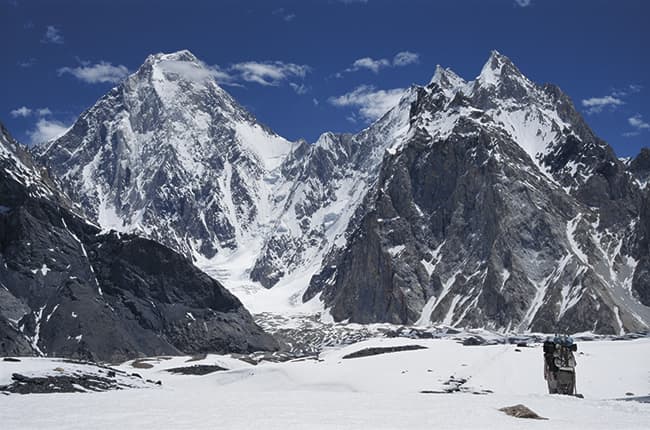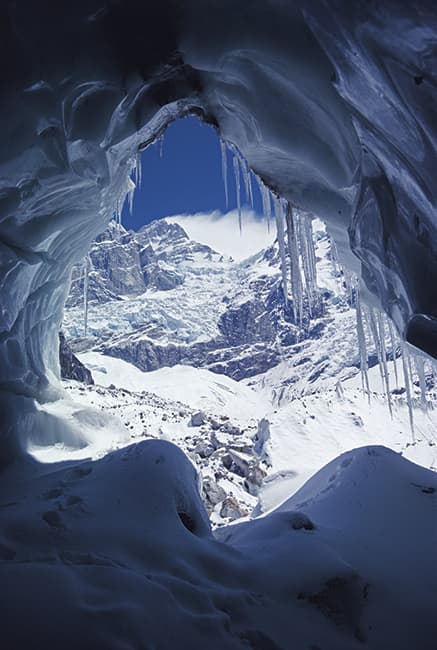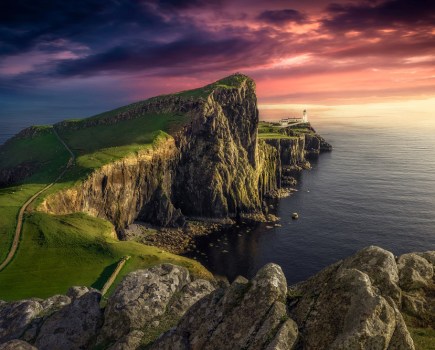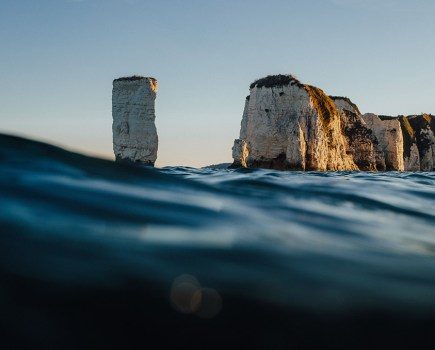Alan Hinkes is a mountaineer, photographer, documentary filmmaker and international mountain guide. He was awarded an OBE in 2006. His book, 8000 Metres: Climbing the World’s Highest Mountains, features a wealth of mountain photograhpy and is available in both hardback, price £25, and Kindle editions, from £16.15. Twitter @alanhinkes
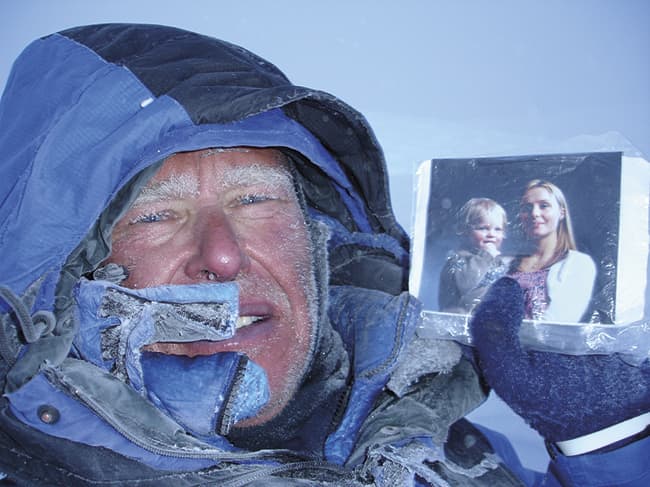
When did you start taking photographs seriously?
I started when I was around 11 years old, using an Ilford 127 rollfilm camera. When I went to Northallerton Grammar School in North Yorkshire, I started processing my own black & white prints and progressed to 35mm.
I was president of the school camera club and took the school photos one year, using 120 rollfilm, and made a profit for the club. I preferred creative photography and went on club trips to places such as York.
I used photography for geography and geology field trips. Later, when I started hill walking and climbing, I carried a camera to photograph the locations.
How important is photography to you when you’re climbing mountains?
I can’t go out without a camera! However, I use a smartphone for Twitter pictures, but I also have a Canon PowerShot G11 and an SLR.
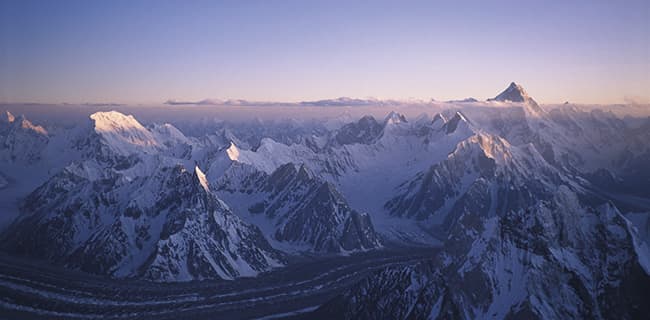
Karakoram, Pakistan. Chogolisa and Masherbrum (K1) above Concordia, the confluence of the Baltoro and Goodwin-Austen Glaciers, seen from high on Broad Peak
What was the most photogenic mountain?
Roseberry Topping in North Yorkshire is photogenic. In terms of the world’s highest mountains, K2 is also very photogenic and stark, as well as dangerous.
What was the most challenging to photograph?
K2, the second highest mountain on Earth. For every four people who climbed it, one has died trying. Kanchenjunga in India – my final 8,000m peak, and the third highest mountain – was also a major challenge to climb and photograph.
Which cameras have you taken with you to climb all of the world’s 8,000m peaks?
I’ve used a range of cameras during my climbs in this 18-year period. They have mostly been compacts and were all film until 2005.
I tried digital in 1997, but the quality was so poor that it put me off for years. The cameras have included Pentax ME Super and MX SLRs, and rangefinder compacts, such as the Olympus 35RC, Ricoh 500G and GR1.
Digital cameras have included a Sony Cyber-shot and Canon PowerShot G11. Carrying film was a problem. I might take 100 rolls of 36-exposure slide film on a climb, which was X-rayed at airports, heated in the day and frozen at night. Now I just take a couple of memory cards.

Karakoram, Pakistan. Chogolisa and Masherbrum (K1) above Concordia, the confluence of the Baltoro and Goodwin-Austen Glaciers, seen from high on Broad Peak
Have you broken or lost equipment on your climbs?
I’m generally very careful, but I did drop a camera on Skye Ridge – as I pulled up my jacket hood, it flicked off the neck strap. I’ve also had a few cameras stolen on trips.
Has equipment failed in extreme conditions?
Not often. I nurture my kit and keep my camera safely inside my clothes. I also use padded camera bags. In case of problems, I carry two cameras or a disposable film camera.
Were there any advantages to using manual cameras and film for mountaineering photography?
Yes and no. I suppose a basic mechanical film camera was a safe bet. However, I’ve found that modern digital cameras also work well.
Facilities such as autofocus and auto exposure, their low-light capability and ability to take hundreds of high-quality images on memory cards make them great to use.
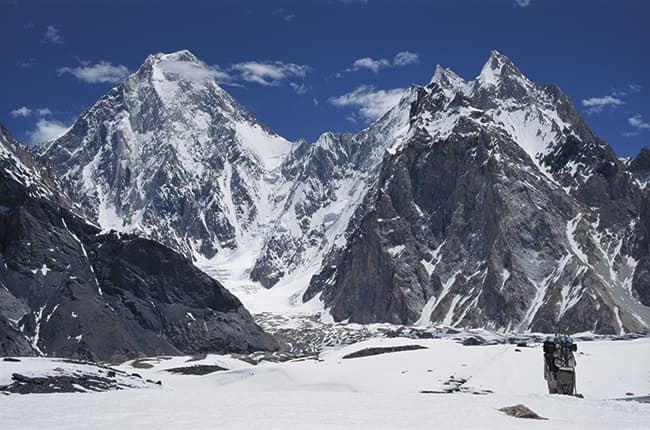
Gasherbrum IV, 7925m, viewed from near Concordia on the Upper Baltoro Glacier. Porters are ferrying loads into Gasherbrum I and Gasherbrum II base camp higher up on the Abruzzi Glacier
How did you get to know Joe Cornish? Has he influenced your work?
Joe is a master landscape photographer and I’ve always admired his images. We live reasonably close to each other in North Yorkshire.
When we eventually met, he told me that he had always admired my climbing. I’ve been out with him several times, and it always amazes me how he can see and capture an image when others would walk past it.
Sometimes, when I’m out, I try to think to myself, ‘What would Joe do?’
How many photographs have you taken on your mountaineering trips?
It’s hard to be exact. A lot of space at home is taken up with negs, prints and slides – most of my slides are unmounted E6, so take up less room. There are more than 50,000 photographs, but there could be 100,000.
Which photos have been the most satisfying to take?
That’s difficult, but my photo of the giant shadow of K2 from its summit, which was about 500-1,000km long, stands out (see image below). Another is my summit shot on Kangchenjunga, taken when I was alone in a blizzard.
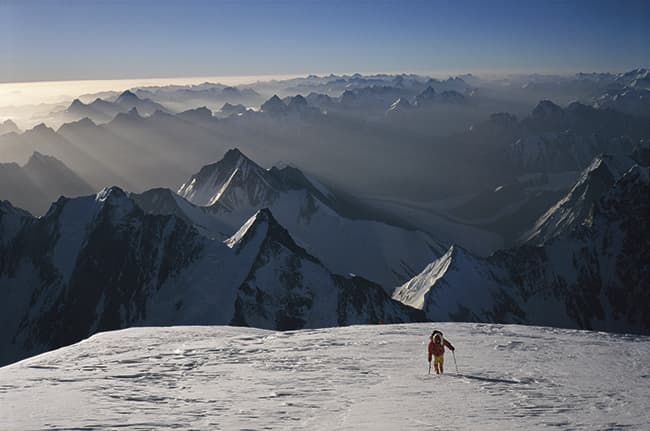
Early morning, setting off from the Shoulder at over 8000m on K2. A Dutch climber follows me up towards the Bottleneck
What’s your nex tmountaineering or photographic project?
At the moment, I’m enjoying climbing the hills and fells of Northern England, particularly in Yorkshire and the Lake District. It’s great to be alive after surviving the ‘death zones’ of all the world’s highest mountains.

